In 2013, the British newspaper The Art Newspaper wrote a note about an Indian copper statuette 30 centimeters high and weighing two kilograms, with a bilingual written on its chest and Harappa hieroglyphs, and brahmi!
The circumstances of the finding of the figurine are unclear, as would be found by a certain Sabdar Ali.

The patina on the statuette was recognized as genuine by the Archaeological Administration of India. It was dated back to the 2nd century BC.
The figurine is a stylized human figure, as the researchers said, with a “boar” head. Of course, it doesn’t look like a boar at all: there is no patch, no fangs, no wedge-shaped muzzle, no boar’s mouth at all … Most of all he looks like a bear. In Hindu mythology, the bear Jambavati or Riksha Raja is mentioned – the king of bears, but belonging to the monkey race , Rama’s assistant.
Now for some reason it is believed that the writing of the cities of the Indus Valley disappears around the 20th century BC, and the earliest Brahmi is known from the 4th-3rd centuries BC. But it is interesting how writing can disappear in a state that did not experience destruction until the 13th century BC. About the brahmi, it is also unknown when it arose, even if so far the inscriptions are known only from the 4th century BC. Already this bronze artifact indicates the mixing of the cultures of the Harappan Dravidians and the conquerors of the Indo-Aryans. That is, it may well refer, for example, to the X century BC …
Researchers who published material about the statuette claim that they managed to read the brahmi inscription. It reads: “King / Ki-Ma-Ji [proper name] Sha-Da-Ya [incarnation of God]” (Interestingly, El-Shaddai is in the Torah “ God Almighty ”. ) . But the question is what god is this Kimaji’s incarnation? It might be more correct like this: “King / Ki-Ma [proper name] Ji (god’s name) – Sha-Da-Ya [incarnation]” Or like this: “King / Ki-Ma [proper name – Kumar] Ji ( the name of the god Jambavati) – Sha-Da-Ya [incarnation] “. But if you read the drawing of a water buffalo on a figure as Wa (water), which seems to follow from the analysis of the characters of the Harappan script ( see ), you get” King / Ki-Ma-Ji [proper name] Sha-Da-Ya [incarnation of God] “Wa (water), which turns out to be quite meaningful text .
The one-horned long-necked bull depicted on the figure’s chest is found hundreds of times on the seals of the Indus Valley civilization. It is often called a unicorn: indeed, the second horn is not found in the images (the animal’s second ear was not drawn either). But usually a unicorn bull is always depicted standing next to some kind of structure – either a cauldron, or a composite bowl on a leg. And on the chest of a boar man, the animal is depicted without this attribute.
About five thousand inscriptions have come down to us from the civilization of the Indus Valley. Most of the inscriptions are found on stamps or stamp impressions. The number of characters in each inscription rarely exceeds 5, and 10 or more characters are found in less than 1 percent of the inscriptions. The longest inscription on one surface consists of 17 characters, on one object – 26.
The most modern and authoritative corpus of Harappan inscriptions consists of 13,372 occurrences of 417 different signs (a total of 2905 inscriptions). 4 of these 417 are the most common: they make up 21 percent of the total. The 20 most common characters make up over 50 percent of the total. At the same time, the repeatability of the most common characters within one inscription is phenomenally low: 5 out of 20 characters are never repeated, and 5 more – only once (in a corpus of almost three thousand inscriptions).
Table of proto-Indian characters in universal encoding
Source – Script Encoding Initiative. Alphabetical List of Scripts Not Yet Encoded. U. C. Berkeley. Department of Linguistics. You will find a link to the PDF on the “Indus Valley Script” line. Download PDF [142 Kb] here.
Code – ISO / IEC JTC1 / SC2 / WG2 N1959. 1999-01-29. Standardization was carried out by M. Everson under the auspices of the International Organization for Standardization (Proposal
for the Universal Character Set by Michael Everson. Universal Multiple-Octet Coded Character Set. International Organization for Standardization. Organization Internationale de Normalization.)
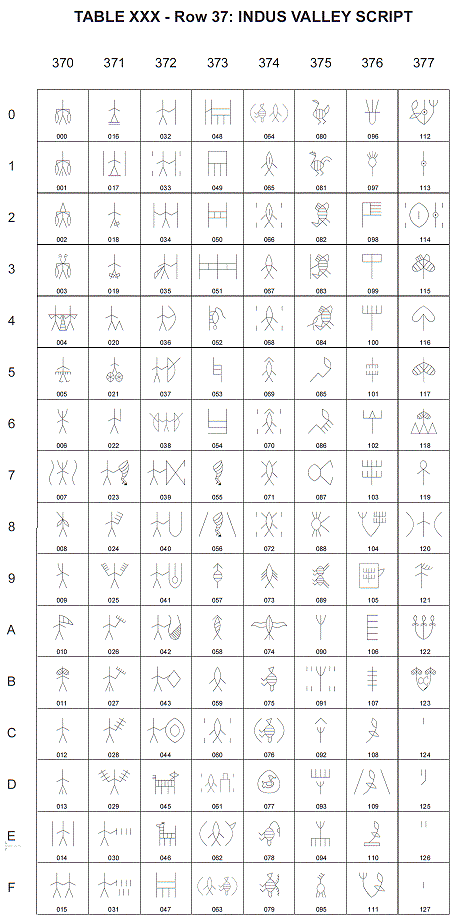
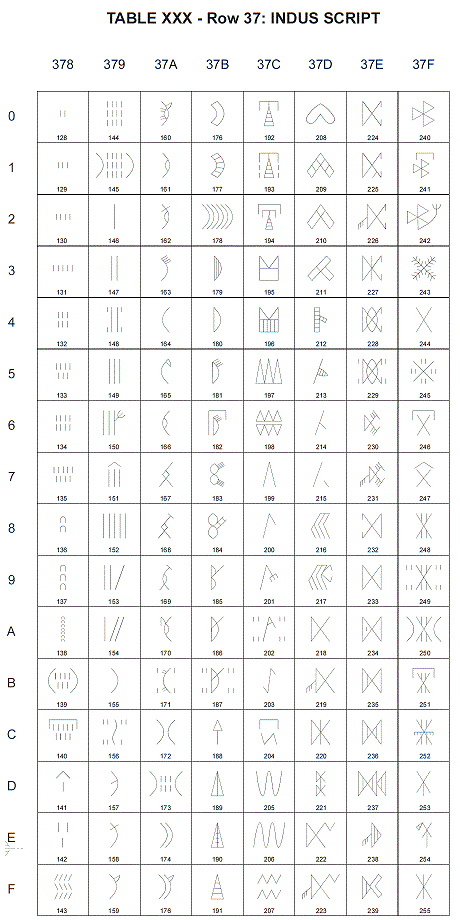
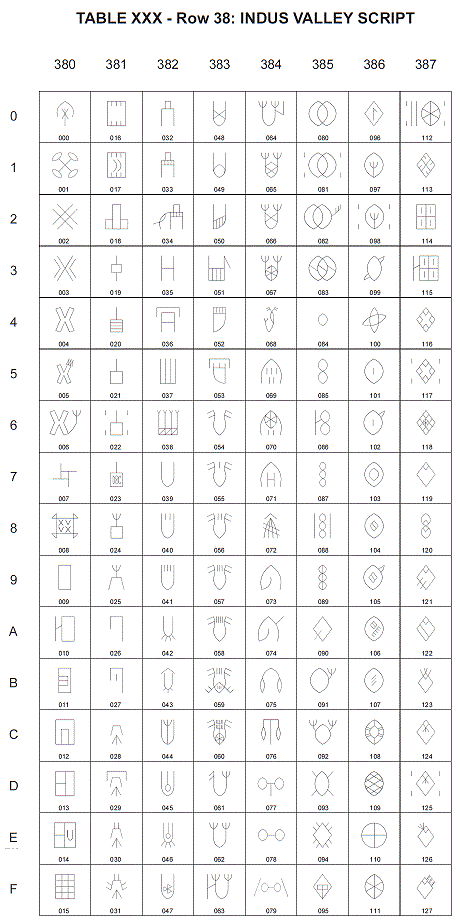
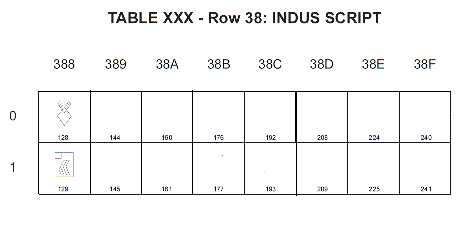
Sample stamps.
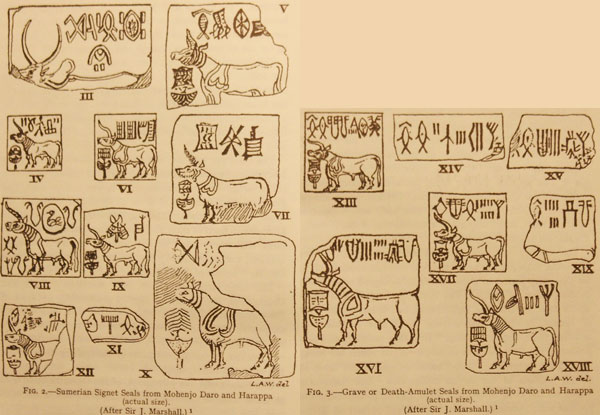

Harappan inscriptions can be deciphered if you understand what is written in them. That is, you need to understand the Harappan mythology. And it is possible.
Not immediately, but Harappan myths were included in the mythology of the Indo-Aryans. Found in 2013 copper figurine with bilingual, texts written in Harappan script and brahmi showed that the Harappan writing did not completely disappear in Aryan India. Most likely, the Brahmi script was created using the ideas of the Harappan script. In the Harappan writing, 129 characters are allocated (there are, of course, several more), that is, these are not hieroglyphs, but syllables, but Brahmi is also a syllabic writing, although syllables in it are often reduced to letters.
The Harappan mythology is easy to spot, as it is what remains when the Vedic mythology is taken away from Hinduism. In Harappan mythology, the eternal deity was the dragon Shesha. He was identified with the Milky Way and time. Shesha’s heads were held by 5 planets known to the Dravidians and many stars. The rest of the gods and demons of the Harappan pantheon descended from Shesha, but the first and most important god of this pantheon was Shiva – the destroyer god, and, at the same time, the creator of the new.
Shiva was revered, first of all, in the form of a Lingam combined with Yoni, and not only in the culture of Harappa, but in many cultures that have a connection with the Indian Ocean.
Perhaps the image of a bull that is frequent in the Harappan graphics, this is also one of the incarnations of Shiva. For some reason, the myths about Shiva the bull mostly did not reach us, although on Indian coins of the beginning of our era, Shiva is often represented in the form of a bull. In addition, the merger of the Vedic deity Rudra and the Dravidian deity Shiva most likely happened precisely because they both had the image of a bull. Here is a myth about this: Rudra, after the destruction of the asuras in the form of a bull, fertilized the Earth, which took the form of a spotted cow. That is, Nandin, Shiva’s companion, should probably be regarded as the embodiment of Shiva himself.
Shiva was also known in the form of a pillar of fire. Here is a myth about this: Brahma and Vishnu quarreled over who was in charge. This dispute continued for quite a long time and ended with the fact that an endless pillar of fire appeared in front of the disputants. Not realizing what it was in front of them, they attacked the pillar with their weapons. When Brahma and Vishnu realized that they could not do any harm to this pillar, they decided to find the beginning and end of this pillar, and Brahma went to look for its upper end, in search of the top, and Vishnu (in the form of Varaha) – the lower one. Not finding a beginning or an end, they met again, and at that moment Shiva came out of the fire pillar-Lingam, who explained to Brahma and Vishnu their real situation.
Another incarnation of Shiva is Hanuman, an ape-like deity, one of the main characters of the Ramayana, the leader of one of the Vanara troops, also a friend of Rama and Sita. The story of this incarnation of Shiva is as follows: The leader of the demons Ravana received from Brahma a blessing that he would not be killed by anyone but a man and a monkey. Vishnu chose the human form, Shiva took the form of a monkey.
Shiva as the main deity of the Harappan people should be mainly of Harappan inscriptions. These inscriptions are not seals at all, but sacred amulets. And what could be the content of short inscriptions on such amulets … Of course, mantras are ritual prayers addressed to the gods. The only expanded inscription on the bronze figurine is also a mantra. There are not so many mantras in Hinduism, but the most important mantra is the appeal to Shiva “Namah Shivaya” – the mantra of the five elements.
And she, apparently, retained the sound of the ancient Harappan hieroglyphs according to her: Yya is the soul, Na is the earth, Ma is water, Shi is fire, Va is air. Then ShiVa is a combination of fire and water, a well-known symbol of Yin and Yang. It turns out that the bull standing after the candlestick in the Harappan inscriptions is the signs Shi – fire and Wa – water.

Harappan notation, where all five elements described in “Namah Shivaya” are indicated, but which sign above the water sign in the form of a bull refers to the earth, which to the air, and which to the soul is to be understood …
